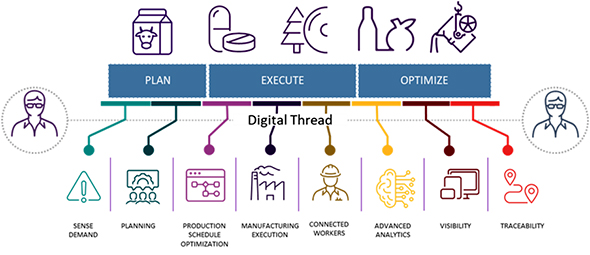Digital Transformation
Digital transformation offers food manufacturers a giant reset button
Manufacturing execution systems support revenue growth while promoting resilience and sustainability in times of disruption and market uncertainty

Modern olive oil production benefits from manufacturing execution systems that provide a level of control not possible before in manufacturing. Image by neufal54 from Pixabay
As the leading Italian producer of extra-virgin olive oil, Farchioni understands the importance of quality and consistency. Every one of the 32 million bottles it produces each year must deliver the same culinary sensation. Just a few drops of this ambrosial gold on a bit of bread, anywhere in the world, can instantly transport diners to the Mediterranean’s sunny climes, to ancient olive groves and abundant tables, surrounded by friends and flowing conversation. Lower-grade versions simply do not have the same effect, and that’s without going into provenance, terroir and the numerous other factors affecting product quality.
But millions of people around the world would not be able to enjoy this magical experience if an entire chain of manufacturing processes didn’t work together flawlessly and in seamless harmony. Once a small business owned by two farmers operating from a single mill in Umbria, Farchioni’s empire now extends to beer, wine and flour, of which 25% is exported around the world.
That level of scale would be impossible without automating traditional manufacturing processes through digital transformation, a development referred to as Industry 4.0. Food and beverage manufacturing increasingly relies on modern technology such as smart data capturing and analysis, inventory and operations management, value optimization, and personalized training. With manufacturing processes calibrated to optimum conditions, production can be maximized while quality remains consistent and wastage is reduced. Alongside, the process yields substantial environmental and sustainability benefits.
For Farchioni, embracing these technologies with AVEVA’s manufacturing execution systems (MESs) didn’t just help to improve yield and reduce manual labor. The solution offers the confidence that each individual bottle within a 3,000-quintal batch of olive oil looks, smells and tastes identical.
Technology helps manufacturers respond to market conditions
As Farchioni shows, implementing digital technology into a plant can bring benefits that improve efficiency and productivity, while raising the quality of finished goods—whether in food or other industries. But is that enough to assure success in the new-normal marketplace, where the impact of Covid-19 remains an ever-present reality?
Perhaps more important in today’s market, digital operations management technologies provide consumer packaged goods manufacturers the ability to calibrate their response to fluctuating market and supply conditions. The industry has complex supply chains that can span continents. The sensitivity of these chains to climate and other environmental issues can cause the cost and availability of ingredients to vary dramatically. These trends have been further amplified by coronavirus-linked work restrictions and altered market demand linked to changing consumer lifestyles, incomes and purchasing patterns.
For instance, in February 2020 for the first time since records were kept, consumers in the US spent more at food service establishments than at retail grocery stores. By the end of the year, spending worth $220 million had shifted from food services to retail sales channels, completely upending supply chains. The situation changed again this year. The two ends of the supply chain intersected at production plants, where workers had to deal with the impact of these demand swings, alongside supply shortages, rapid on-boarding of new suppliers and packaging changes—all in the face of a growing labor shortage.

Optimize the value chain with a digital thread
Digital manufacturing technologies can go a long way to optimizing the value chain to create resilience and agility, and to build sustainable, future-proof industrial operations that can respond swiftly to changing market dynamics. At its heart, value chain optimization is a digital thread that connects the consumer to and from the plant floor, allowing manufacturers in every sector to grow their revenue and improve their profitability with sustainable practices that meet their commitments to their customers, employees and communities.
This digital thread begins at the point of demand and runs through the supply chain to help build a realistic sales and operations plan that factors in customer service priorities and business KPIs. It factors in operational imperatives such as the cost of production and availability of materials, labor and equipment. These often contradicting drivers have to be reconciled into an optimized production schedule that balances these competing goals—in a plan that must be executed at the lowest possible cost. Manufacturing execution systems typically manage this work, using digital tools for mobility, collaboration and knowledge sharing to ensure maximum productivity.

But people and technology are only two elements of a transformation plan. The third, process, is where digital transformation has a major additional impact. As plants become increasingly agile, the pace of change accelerates, bringing with it the need for recurring improvements. Advanced analytics and AI can deliver this continual optimization of shop floor processes and provide operators with key insights into productivity improvements.
Finally, a digital thread offers visibility for all stakeholders—from the customer to the supply chain planner to the plant floor operator—into the plan’s execution. An agile plant needs to be able to respond quickly to the unexpected, so if a major piece of equipment fails, plans can be reoptimized quickly and customer impacts communicated.
Realize the advantages of digital manufacturing systems
Whether it is an olive oil producer or a manufacturer of candy bars, digital Manufacturing Execution Systems that optimize the value chain have several significant benefits:
- Improved manufacturing agility and resilience
- Ensured sustainability and environmental health and safety
- On-time and in full delivery
- Increased productivity
- Improved quality
- Increased performance
- Transparency and traceability
- Reduced non-compliance
Despite technological advances in processing and ingredients, most plants are still collecting and sorting data manually. Transforming this process across a digital thread facilitates optimized performance while supporting revenue growth and sustainability. With this approach, systems can be standardized across plants to leverage supply chain-wide improvements.
Over the past year, we have witnessed developments that may have taken decades to come about to be compressed into the space of a few months. These developments have led the World Economic Forum to describe a “Great Reset” of the business of manufacturing. With an uncertain business outlook likely to persist for the foreseeable future, only advanced technology solutions can enable manufacturers to stay resilient and responsive within a dynamic business environment. The time to hit the ‘Reset’ button is now.
For more information, https://www.aveva.com/en/industries/food-beverage/
Looking for a reprint of this article?
From high-res PDFs to custom plaques, order your copy today!








